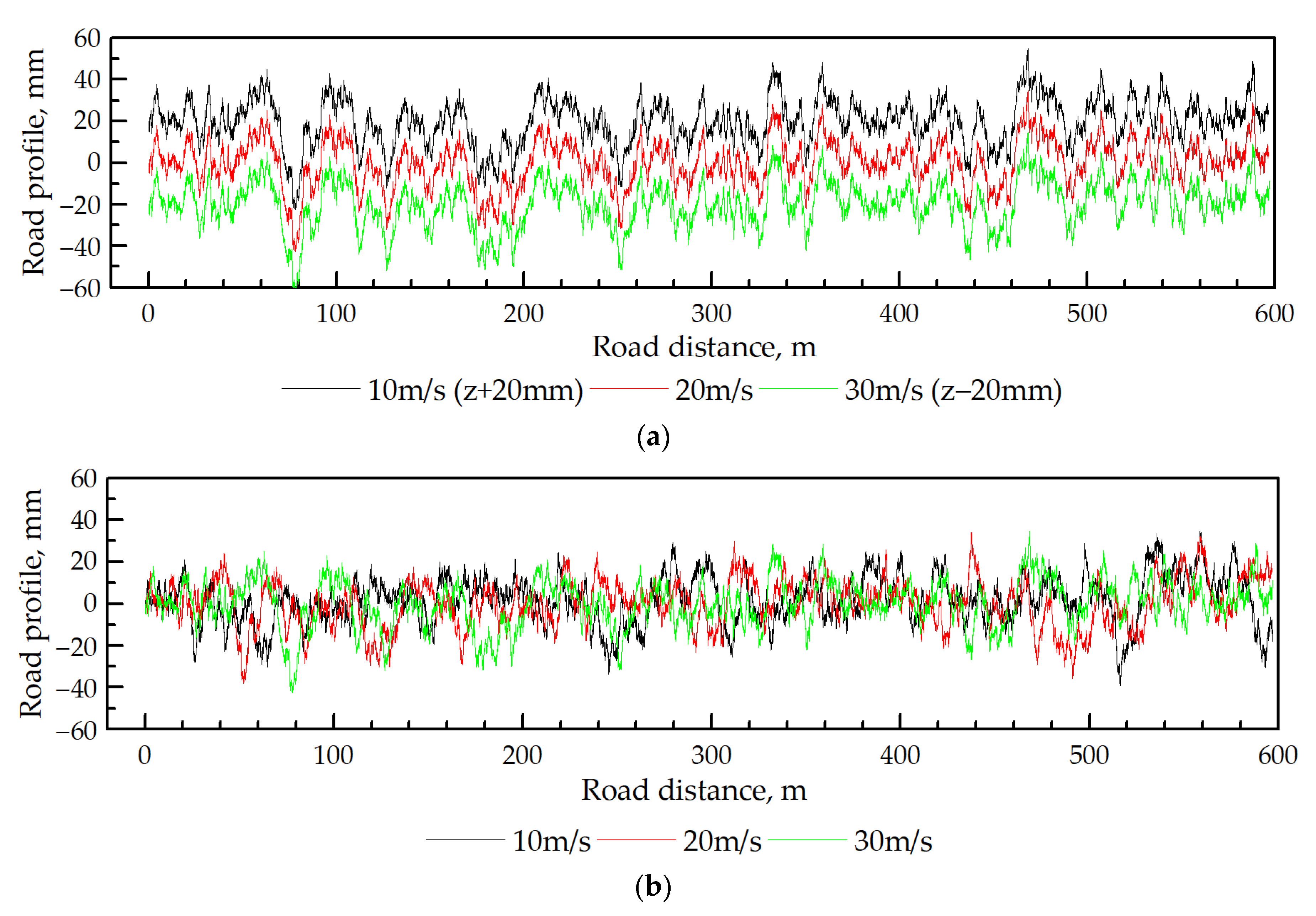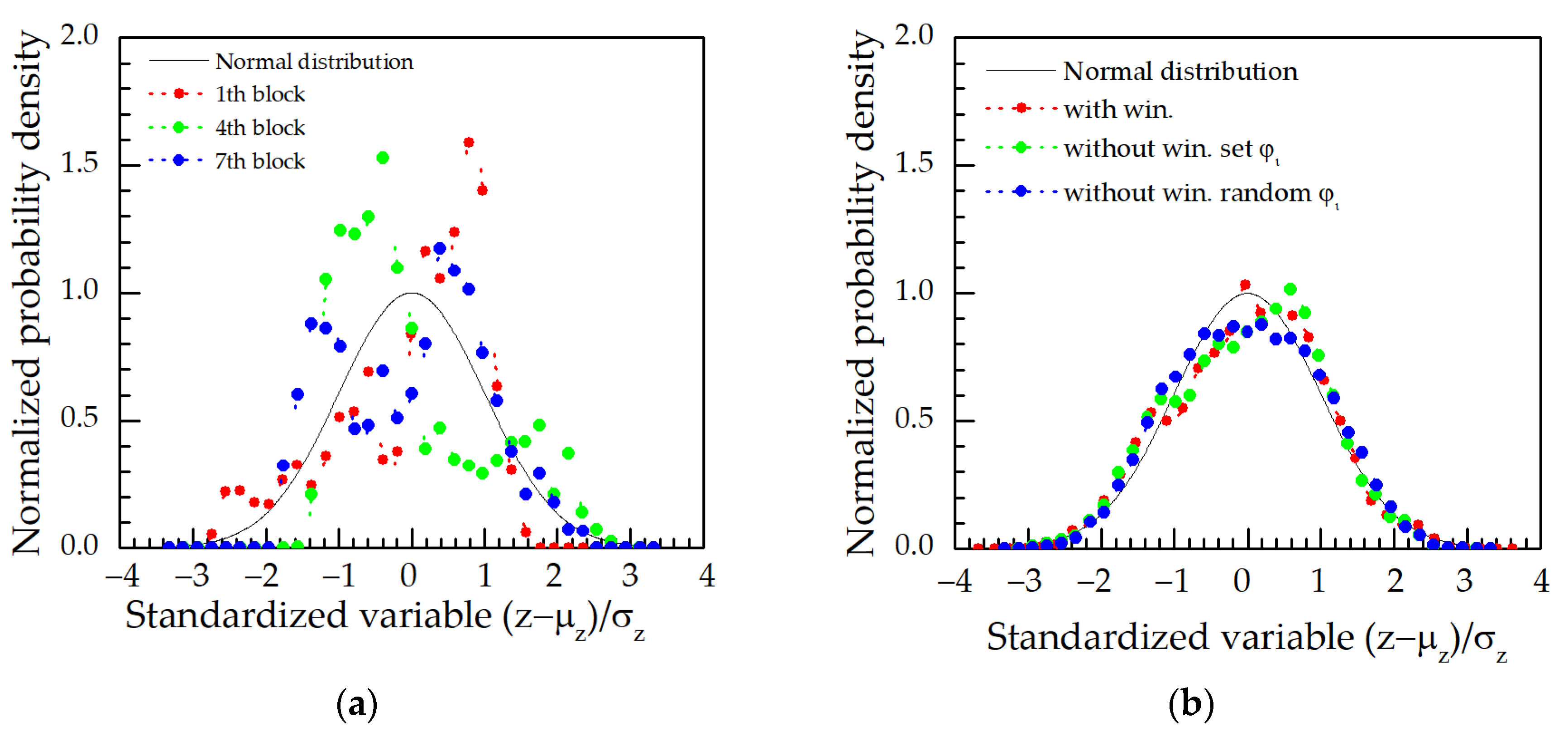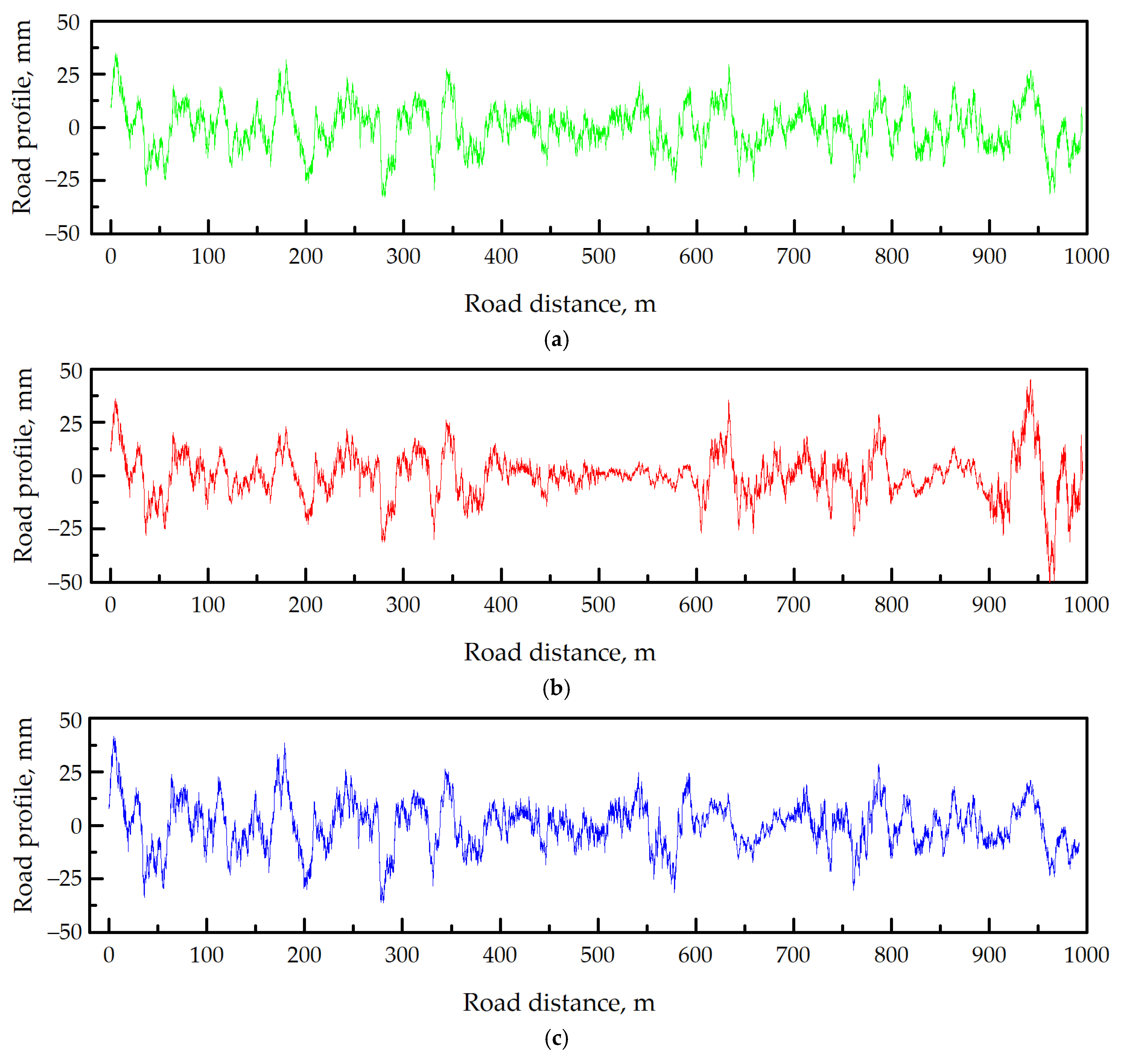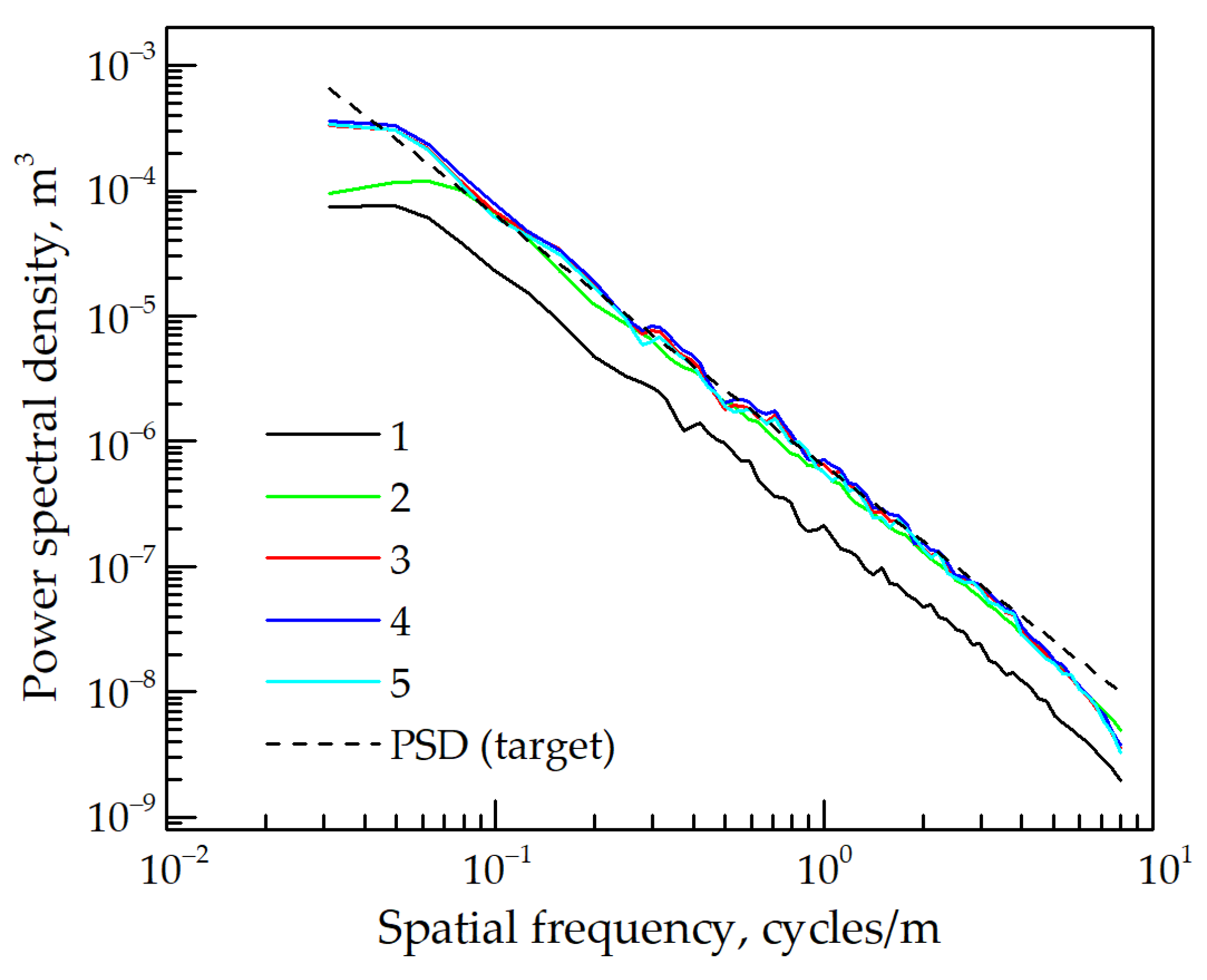Road Surface Profile Synthesis: Assessment of Suitability for Simulation
Abstract
:1. Introduction
2. Road Profile Simulation
2.1. White Noise Filtration
2.2. Sinusoidal Approximation
2.3. Moving Average of White Noise
3. Implementation of Simulations
3.1. White Noise Filtration
3.2. Sinusoidal Approximation
3.3. Moving Average of White Noise
4. Simulation Results and Discussion
4.1. White Noise Filtration
4.2. Sinusoidal Approximation
4.3. Moving Average of White Noise
5. Conclusions
Author Contributions
Funding
Data Availability Statement
Conflicts of Interest
References
- Sayers, M.W.; Karamihas, S.M. The Little Book of Profiling: Basic Information about Measuring and Interpreting Road Profiles; Regent of the University of Michigan: New York, NY, USA, 1998. [Google Scholar]
- Loprencipe, G.; Cantisani, G. Unified Analysis of Road Pavement Profiles for Evaluation of Surface Characteristics. Mod. Appl. Sci. 2013, 7, 1. [Google Scholar] [CrossRef]
- Bitelli, G.; Simone, A.; Girardi, F.; Lantieri, C. Laser Scanning on Road Pavements: A New Approach for Characterizing Surface Texture. Sensors 2012, 12, 9110–9128. [Google Scholar] [CrossRef] [PubMed]
- Martin, D.J.; Nelson, P.M.; Hill, R.C. Measurement and Analysis of Traffic-Induced Vibrations in Buildings; TRRL Supplementary Report 402; Transport and Road Research Laboratoty: Crowthorne, Berkshire, UK, 1978. [Google Scholar]
- Watts, G.R. The Effects of Traffic Induced Vibrations on Heritage Buildings: Further Case Studies; Research Report 207; Eff. Traffic Induc. Vib. Herit. Build. Furth. Case Stud.; Transport and Road Research Laboratory (TRRL): Crowthorne, Berkshire, UK, 1989. [Google Scholar]
- Hajek, J.J.; Blaney, C.T.; Hein, D.K. Mitigation of Highway Traffic-Induced Vibration. In Proceedings of the 2006 Annual Conference of the Transportation Association of Canada, Charlottetown, PE, Canada, 17–20 September 2006. [Google Scholar]
- Sayers, M.W.; Gillespie, T.D.; Queiroz, C.A.V. The international road roughness experiment: A basis for establishing a standard scale for road roughness measurements. Transp. Res. Rec. 1986, 1084, 76–85. [Google Scholar]
- Paterson, W.D.O. Road Deterioration and Maintenance Effects: Models for Planning and Management; World Bank: Washington, DC, USA, 1987; ISBN 978-0-8018-3590-2. [Google Scholar]
- Hassan, R.; Mcmanus, K.; Holden, J. Predicting Pavement Deterioration Modes Using Waveband Analysis. Transp. Res. Rec. 1999. [Google Scholar] [CrossRef]
- Ngwangwa, H.M.; Heyns, P.S.; Labuschagne, F.J.J.; Kululanga, G.K. Reconstruction of road defects and road roughness classification using vehicle responses with artificial neural networks simulation. J. Terramechanics 2010, 47, 97–111. [Google Scholar] [CrossRef] [Green Version]
- Wambold, J.C. The measurement and data analysis used to evaluate highway roughness. Wear 1979, 57, 117–125. [Google Scholar] [CrossRef]
- ISO 8608:2016. Available online: https://www.iso.org/cms/render/live/en/sites/isoorg/contents/data/standard/07/12/71202.html (accessed on 11 May 2020).
- Loprencipe, G.; Zoccali, P. Use of generated artificial road profiles in road roughness evaluation. J. Mod. Transp. 2017, 25, 24–33. [Google Scholar] [CrossRef] [Green Version]
- Hać, A. Suspension optimization of a 2-DOF vehicle model using a stochastic optimal control technique. J. Sound Vib. 1985, 100, 343–357. [Google Scholar] [CrossRef]
- Giua, A.; Melas, M.; Seatzu, C.; Usai, G. Design of a Predictive Semiactive Suspension System. Veh. Syst. Dyn. 2004, 41, 277–300. [Google Scholar] [CrossRef]
- Yoshimura, T. A semi–active suspension of passenger cars using fuzzy reasoning and the field testing. Int. J. Veh. Des. 1998, 19, 150–166. [Google Scholar] [CrossRef]
- ElMadany, M.M.; El-Tamimi, A. On a subclass of nonlinear passive and semi-active damping for vibration isolation. Comput. Struct. 1990, 36, 921–931. [Google Scholar] [CrossRef]
- Faris, W.; BenLahcene, Z.; Hasbullah, F. Ride quality of passenger cars: An overview on the research trends. Int J. Veh. Noise Vib. 2012, 8, 185–199. [Google Scholar] [CrossRef]
- Melcer, J.; Lajčáková, G. Numerical simulation of vehicle motion along the road structure. Rocz. Inż. Bud. 2012, 12, 37–42. [Google Scholar]
- Bogsjö, K.; Rychlik, I. Vehicle fatigue damage caused by road irregularities. Fatigue Fract. Eng. Mater. Struct. 2009, 32, 391–402. [Google Scholar] [CrossRef]
- Schiehlen, W. White noise excitation of road vehicle structures. Sadhana 2006, 31, 487–503. [Google Scholar] [CrossRef] [Green Version]
- Yonglin, Z.; Jiafan, Z. Numerical simulation of stochastic road process using white noise filtration. Mech. Syst. Signal. Process. 2006, 20, 363–372. [Google Scholar] [CrossRef]
- Tyan, F.; Hong, Y.-F.; Shun, R.; Tu, H.; Jeng, W. Generation of Random Road Profiles. J. Adv. Eng. 2009, 4, 151–156. [Google Scholar]
- Dharankar, C.S.; Hada, M.K.; Chandel, S. Numerical generation of road profile through spectral description for simulation of vehicle suspension. J. Braz. Soc. Mech. Sci. Eng. 2017, 39, 1957–1967. [Google Scholar] [CrossRef]
- Goenaga, B.J.; Fuentes Pumarejo, L.G.; Mora Lerma, O.A. Evaluation of the methodologies used to generate random pavement profiles based on the power spectral density: An approach based on the International Roughness Index. Ing. Investig. 2017, 37, 49. [Google Scholar] [CrossRef] [Green Version]
- Dodds, C.J.; Robson, J.D. The description of road surface roughness. J. Sound Vib. 1973, 31, 175–183. [Google Scholar] [CrossRef]
- Andren, P. Power spectral density approximations of longitudinal road profiles. Int. J. Veh. Des. 2006, 40, 2–14. [Google Scholar] [CrossRef]
- Charles, D. Derivation of Environment Descriptions and Test Severities from Measured Road Transportation Data. J. IES 1993, 36, 37–42. [Google Scholar] [CrossRef]
- Bruscella, B.; Rouillard, V.; Sek, M. Analysis of Road Surface Profiles. J. Transp. Eng. 1999, 125, 55–59. [Google Scholar] [CrossRef]
- Rouillard, V. Decomposing pavement surface profiles into a Gaussian sequence. Int. J. Veh. Syst. Model. Test. 2009, 4, 288. [Google Scholar] [CrossRef]
- Bogsjö, K.; Podgórski, K.; Rychlik, I. Models for road surface roughness. Veh. Syst. Dyn. 2012, 50, 725–747. [Google Scholar] [CrossRef]
- Johannesson, P.; Rychlik, I. Laplace Processes for Describing Road Profiles. Procedia Eng. 2013, 66, 464–473. [Google Scholar] [CrossRef] [Green Version]
- Johannesson, P.; Rychlik, I. Modelling of road profiles using roughness indicators. Int. J. Veh. Des. 2014, 66, 317. [Google Scholar] [CrossRef]
- Sun, L. Simulation of pavement roughness and IRI based on power spectral density. Math. Comput. Simul. 2003, 61, 77–88. [Google Scholar] [CrossRef]
- Agostinacchio, M.; Ciampa, D.; Olita, S. The vibrations induced by surface irregularities in road pavements—A Matlab® approach. Eur. Transp. Res. Rev. 2014, 6, 267–275. [Google Scholar] [CrossRef] [Green Version]
- Sun, L.; Kennedy, T.W. Spectral Analysis and Parametric Study of Stochastic Pavement Loads. J. Eng. Mech. 2002, 128, 318–327. [Google Scholar] [CrossRef]
- Shinozuka, M.; Jan, C.-M. Digital simulation of random processes and its applications. J. Sound Vib. 1972, 25, 111–128. [Google Scholar] [CrossRef]
- Shinozuka, M. Monte Carlo solution of structural dynamics. Comput. Struct. 1972, 2, 855–874. [Google Scholar] [CrossRef]
- Gorges, C.; Öztürk, K.; Liebich, R. Road classification for two-wheeled vehicles. Veh. Syst. Dyn. 2018, 56, 1289–1314. [Google Scholar] [CrossRef]
- Shannon, C.E. Communication in the Presence of Noise. Proc. IRE 1949, 37, 10–21. [Google Scholar] [CrossRef]
- Shinozuka, M.; Deodatis, G. Simulation of Stochastic Processes by Spectral Representation. Appl. Mech. Rev. 1991, 44, 191–204. [Google Scholar] [CrossRef]
- Hu, B.; Schiehlen, W. On the simulation of stochastic processes by spectral representation. Probabilistic Eng. Mech. 1997, 12, 105–113. [Google Scholar] [CrossRef]








| Method | Characteristics | Validation | Ref. |
|---|---|---|---|
| White noise filtration; sinusoidal approximation; moving average of white noise | White noise; PSD; Kurtosis | Comparison to the ISO 8608 standard, evaluation of Gaussianity | This work |
| White noise filtration | White noise; coordinates | Evaluation of PSD | [22] |
| Sinusoidal approximation; first order filter | PSD | - | [23] |
| Gaussian white noise; superposition of harmonics | White noise; PSD; spatial frequency | Comparison to the ISO 8608 standard | [24] |
| Sinusoidal approximation | Spatial frequency | - | [25] |
| Hybrid (Gaussian and white noise) | Power spectrum; vehicle speed; standard deviation | - | [31] |
| Laplace processes | Kurtosis | Comparison to the real road | [32] |
| Gaussian random field | PSD roughness | Steady state analysis | [34] |
| Gaussian random field | PSD | - | [35] |
| Method | Advantages | Disadvantages |
|---|---|---|
| White noise filtration | Direct use in Simulink. | Only three parameters: . One must use the appropriate simulation parameters to get correct results (velocity, sample time). |
| Sinusoidal approximation | Differentiations without going through numerical differentiation. Maximum possible parameters.Possible various PSD approximations. | Repeatability of profile segments or abrupt shift. Greater computation time. Only stationary Gaussian processes. |
| Moving average of white noise | Possible various PSD approximations. No repeatability of profile segments. Possible stationary or non-stationary Gaussian/Laplace processes. |
Publisher’s Note: MDPI stays neutral with regard to jurisdictional claims in published maps and institutional affiliations. |
© 2020 by the authors. Licensee MDPI, Basel, Switzerland. This article is an open access article distributed under the terms and conditions of the Creative Commons Attribution (CC BY) license (http://creativecommons.org/licenses/by/4.0/).
Share and Cite
Lenkutis, T.; Čerškus, A.; Šešok, N.; Dzedzickis, A.; Bučinskas, V. Road Surface Profile Synthesis: Assessment of Suitability for Simulation. Symmetry 2021, 13, 68. https://doi.org/10.3390/sym13010068
Lenkutis T, Čerškus A, Šešok N, Dzedzickis A, Bučinskas V. Road Surface Profile Synthesis: Assessment of Suitability for Simulation. Symmetry. 2021; 13(1):68. https://doi.org/10.3390/sym13010068
Chicago/Turabian StyleLenkutis, Tadas, Aurimas Čerškus, Nikolaj Šešok, Andrius Dzedzickis, and Vytautas Bučinskas. 2021. "Road Surface Profile Synthesis: Assessment of Suitability for Simulation" Symmetry 13, no. 1: 68. https://doi.org/10.3390/sym13010068
APA StyleLenkutis, T., Čerškus, A., Šešok, N., Dzedzickis, A., & Bučinskas, V. (2021). Road Surface Profile Synthesis: Assessment of Suitability for Simulation. Symmetry, 13(1), 68. https://doi.org/10.3390/sym13010068







